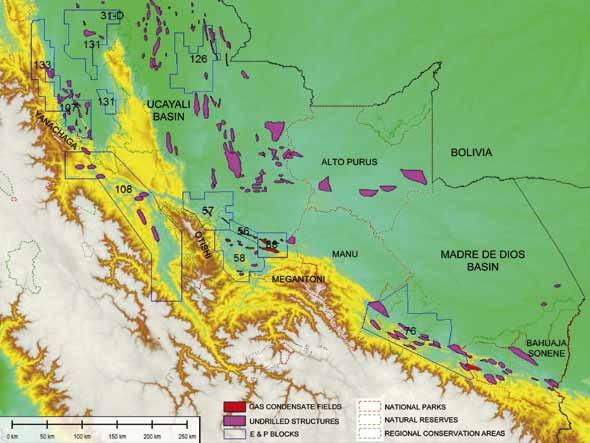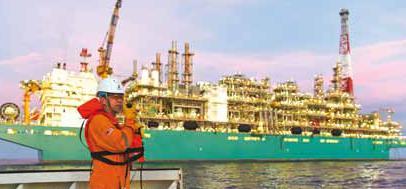
23 minute read
Shale gas in China: some delays for a strong take-off?
by IGU
By Nabila Chafai
x Figure 1.
Introduction
China is a major gas producer, importer and consumer. Since the early 2000s, the country’s rapid economic growth has led to a significant increase in energy demand. Although gas remains low in the energy mix (6% in 2015) relative to competing energies, notably coal (66% in 2015), the growth in demand bears witness to the increasing gas needs in China.
Between 2007 and 2013, gas demand in China more than doubled, mainly driven by three sectors: industry, residential and power generation, propelling the country to third place in the world rankings after the USA and Russia in terms of gas consumption. But by 2014, the economic downturn in China led to a reduction in the rate of growth of energy and gas demand, with the country investing more in services and less in industry. Gas demand growth fell from a double-digit rate to 9.6% in 2014 and 4.7% in 2015.
Historical gas consumption and production in China
Bcm 200 180 160 140 120 100 80 60 40 20 0
2001 2003 2005 2007 2009 2011 2013 2000 2002 2004 2006 2008 2010 2012 2014
Consumption Production
Source: BP Statistical Review of World Energy.
These elements cast doubt about the achievement of Chinese gas production targets, particularly for shale gas. Shale gas production in China started in 2014 with small quantities (0.6 bcm) and targets up to 2040 are very high aiming to satisfy 11% of total gas demand. The New Policies Scenario (NPS) in IEA’s World Energy Outlook 2015 (WEO) predicts that China could produce 30 bcm of shale gas in 2020 and 90 bcm in 2040. But lower prospects for gas demand growth in China lead us to ask some questions about the targets for gas production, in particular for shale gas in the medium and long term. In 2014, the Chinese government reduced shale gas production targets for 2020 by 50% to 30 bcm from 60-100 bcm. This revision raises the question, in particular, of the volume of pipeline and LNG imports needed to satisfy gas demand, as well as the production volumes of shale gas for 2020 and beyond.
With this in mind, IGU’s Gas Markets Committee Study Group 1 investigated gas demand scenarios and assessed their impact on Chinese gas supply up to 2040 looking at conventional gas, coal-bed methane (CBM), shale gas and gas imports by pipeline and LNG. In order to carry out these calculations, version 3.12 of Nexant’s World Gas Model (WGM) created in May 2016 was used. Two scenarios were modelled: a base case where gas demand corresponds to IEA’s NPS and a low demand scenario utilising 2016 data from the Oxford Institute of Economic Studies (OIES) where cumulative gas demand in China over the period 2015-2040 is 16% less. The conclusion of the study is that in the low demand scenario total gas production (including shale gas production) over the period 2015-2040 is 10% less
and imports (LNG and pipeline) 22% less in cumulative terms. In particular, the large-scale development of shale gas production is postponed by almost a decade and is 31% less in cumulative terms between 2015 and 2040.
The present study will be included within the Gas Markets Committee report being prepared for the 27th World Gas Conference to be held in Washington DC in June 2018. The results of this study will be included in the report of the subgroup (part of the Gas Markets Committee) in charge of gas-demand analysis and projections of gas supply in the world to 2040. A presentation of the report is expected at the conference.
Uncertainties about Chinese gas demand
With 188 bcm of gas consumed and 132 bcm of gas produced in 2014, China ranks as the third-largest gas consumer and the sixth-largest producer in the world. This appetite for gas began in the early 2000s, when economic growth started to reach double digits, involving a dramatic and substantial growth in average annual gas demand of 16% between 2009 and 2013.
It was only during the second half of the decade that gas demand started to outstrip domestic production (gas demand rose more than sevenfold between 2000 and 2013, while domestic production tripled), requiring pipeline and LNG imports and supply lines to be put in place. Gas imports dependency rose from 0 to 32% during this period. The energy policy had to find a right balance between providing affordable gas supplies and setting a city gate gas price formula which stimulates more domestic production and higher import levels amid ever-growing demand. This should encourage gas penetration in the energy mix (targetting 5%in 2020 and 10% in 2040 according to the last IEA World Energy Outlook).
From 2011, China’s National Development and Reform Commission (NDRC), the main state agency for economic planning, undertook a reform of Chinese natural gas pricing in the domestic market. The aim was to realign domestic gas prices to a benchmark of international fuel prices (LPG, fuel oil), replacing the fragmented, cost-plus onshore gas-pricing regime with one that features China’s regional prices based on netback market values of competitive fuels at Shanghai city gate, and indexation to oil products. With growing gas import needs, the previous gas-pricing mechanism was constraining the imported volumes bought at a higher price than cheaper domestic gas, which was sufficient to satisfy Chinese demand. Some Chinese midstream and upstream operators lost money in purchasing gas at a high price and selling it at a low price in the domestic market because of the distortion of the gas-pricing mechanism. This step to a more liberalised pricing mechanism was implemented in June 2013 after two trials in Guangdong and Guangxi provinces.
This gas reform resulted in a sharp rise in gas prices in the non-residential sector beyond the level of international LNG spot prices. As a result, gas lost its competitiveness against coal and LPG at the end of 2014, whose prices have fallen since mid-2014. Growth in demand for gas has further slowed to a point where the very optimistic outlook in June 2014 set by the NDRC for a significant increase in demand at more than 400 bcm and a production capacity of 420 bcm/year by 2020 were revised downward to 360 bcm. China National Petroleum Corporation (CNPC), the largest oil and gas producer in China, also revised downward its prospects for 2020 to less than 300 bcm in December 2015. In 2015, China consumed 197 bcm of gas, well below the IEA prospect, given barely two years before, of 250 bcm (see Figure 2).
The Chinese gas sector faces many challenges, both internal and external, up to 2020.
On the one hand, the domestic landscape is undergoing an important transformation: ◆
On the supply side: higher domestic supplies are coming with emerging high volumes of shale gas (even if the targets were revised
Scenarios of Chinese gas demand and gas balance
Bcm
600
500
400
300
200
100
v Figure 2.
v Table 1.
0
2015 2020
WGM Medium shale (IEA NPS 2015) LNG imports Pipeline imports CBM Conventional and tight gas 2025 2030
Chinese gas demand Medium IEA 2013 NDRC June 2014 Chinese gas demand medium IEA 2015 CNPC December 2015
Source: WGM Nexant May 2016, WEO IEA 2015, EDF R&D.
2035 2040
Sources of Chinese gas imports
Qatar Australia Malaysia Indonesia Yemen Equatorial Guinea Nigeria Others Turkmenistan Uzbekistan / Kazakhstan Myanmar
Source: OIES, Pang 2015. LNG 9.2 5.2 4.1 3.5 1.4 1.0 0.6 2.1 Pipeline
25.5 2.7 3.0
down by 50%) and ramping up of conventional outputs as a result of higher domestic prices. In addition, higher LNG and pipeline imports (Eastern and Western Russian routes, reinforcement of Central Asian pipelines) could enhance overcapacity of Chinese gas supplies and thus put more pressure on gas prices. ◆ On the demand side: the continuous slowing down of growth of gas demand casts doubt about the future aggressive trend encouraged by a government targetting transition from coal and oil to gas because of air pollution.
On the other hand, the external environment is increasingly challenged:
More competition for LNG volumes, despite new volumes which will be coming onstream from the US and Australia before the end of the decade.
Oil, LPG and coal-price volatility which will play a role in the competitiveness of gas uses for the power generation, industry and residential sectors.
Given this complex picture, it seems clear that all these factors (gas price reform, huge resources of shale gas, pipeline projects for the Eastern and Western Russian routes, more gas imports from Turkmenistan and Central Asian countries and competition on LNG markets), contribute to contain the uncertainty about the future progression of gas demand in China.
At the same time, a dilemma appears: will it be more economical to develop shale gas and to target more volumes with a different
Gas production and consumption zones in China
agenda, or to encourage LNG and pipeline imports in order to satisfy a gas demand, which is expected to continue its slowdown and could strengthen the overcapacity on contracted imported volumes? We will try to answer these questions in our scenarios.
Methodology Model used
Since the 2000s, China has been both a conventional and unconventional gas producer, with shale gas, tight gas and CBM volumes. More than half of conventional production comes from four basins: Ordos, Sichuan, Tarim and the South China Yangtze Platform. Conventional gas production has reached a plateau. Most deposits have been exploited for a long time and are entering their end-of-life cycle. However, China continues to make important discoveries.

Source: Woodmac, 2016.
Huge resources of shale gas rank China first above the United States, giving the country a potential opportunity to diversify supply and to fight pollution problems mainly linked to coal use. Shale gas resources are distributed across eight basins: Sichuan, Tarim, Junggar, Songliano, Yangtze, Subei, Ordos and Qaidam. In our study, according to data available from the WGM database and external publications, we consider only three for the whole shale gas production: the Sichuan, Tarim and Yangtze basins.
The WGM is a linear programming model (using simplex method) which optimises gas flows by minimising supply costs under constraints of demand, storage and supply capacities (pipeline, LNG). Data is optimised quarterly. At the optimum, the supply satisfies demand based on production profiles and on LNG and pipeline imports. Shadow prices (long run marginal costs or LRMC) are output from the model. In the WGM, demand forecasts for each country and thus for China are exogenous and the model will output the optimum supply (production profiles and trade flows in pipeline and LNG) that meets this demand input. The objective function is a weighted equation of volumes and costs that the model minimises year by year up to 2040. The study horizon is 2015-2040.
As China is a large country in terms of population, geographic extent and demographics, any analysis of natural gas market developments needs to capture its regional variations. In the model, China is represented through nine regional nodes: North, North West, South, South West, East, North East, Central, Hong Kong and Taiwan. In the WGM, all the Chinese nodes are supplied either by LNG and/or by pipeline and/or by other Chinese nodes.
Description of scenarios
In order to quantify the impact of growing or slowing gas demand in China on shale gas production to 2040, two gas demand scenarios were modelled: a base case and a low-demand scenario. The goal is to see if shale gas production targets fixed by the NDRC can be achieved by 2020 (30 bcm) and 2040 (90 bcm). The assumptions for the demand scenarios are: ◆
Base case: In this scenario, gas demand is considered as medium and is based on IEA’s
NPS reaching 629 bcm in 2040.
Low demand scenario: In this scenario, based on a CNPC business-as-usual scenario from 2015 published in an OIES analysis of
Asian LNG demand, gas demand is 9% lower than IEA’s NPS in 2015 and an average of 16% lower over the whole period reaching 566 bcm in 2040.
Concerning shale gas production, a medium level of shale production is considered, based on IEA WEO data, which targets 30 bcm in 2020 and 90 bcm in 2040. If we consider the recent publications about shale gas production in China, and according to the IEA WEO, Chinese shale gas well drilling costs remain significantly higher than those in North America.
The range for China is $8-11m/well in comparison with $5-7m for North America leading to a production cost of around $10/MMBtu. Therefore, we decided to consider an LRMC for Chinese shale gas at almost
x Figure 3.
Gas balance base case and low demand scenarios
Bcm 700
600
500
400
300
200
100
0
2015 2020
Shale gas production Net LNG imports Net pipeline imports Gas production (CBM/Tight/Conventional) 2030 2040
Low demand scenario (Data: OIES 2016) Base case scenario demand
Source: WGM Nexant May 2016, EDF R&D, OIES 2016.
Message from the Chairperson of Beijing Gas Group
Since the middle of the 20th century, coal and oil as major fuel sources have provided a strong impetus for global industrial progress, but also exerted an increasingly severe impact on air quality. In 2016, the Paris Agreement entered into force thanks to the leadership of China and the United States, signifying a transformation towards green, low carbon and sustainable development.
In the past year, global primary energy consumption reached nearly 12.8 billion tons of oil equivalent, a mere 0.8% increase year-on-year, registering the lowest growth rate since the 1990s except during the time of the Asia financial crisis. However, transformation of the global energy consumption structure has been accelerating. Natural gas is playing a more prominent role in this transformation, accounting for 24.9% of primary energy consumption, a 0.3% increase.
The US shale gas revolution significantly raised the evaluation of natural gas reserves and changed the previous pessimistic expectation. Natural gas is recognised as a main source of energy with great potential for further development. Such

recognition will provide strong support to the development of the natural gas industry. As a low carbon, clean energy, natural gas is the primary option for countries as an alternative energy, therefore enjoying huge scope for further growth. Despite decreases from Korea and Japan, consumption growth in China and India will sustain the dynamism of the Asia Pacific market and become the main engine driving global consumption growth.
The 5.6 trillion cubic metres of recoverable natural gas reserves provide strong support for China’s supply security. To address air pollution, wider usage of natural gas in China has become the focus of the Chinese energy sector. Natural gas consumption will continue to increase, reaching up to 10% in the primary energy consumption.
The Chinese government’s dedication to push forward ‘energy transformation’ and address environmental issues provides a great opportunity for the development of the country’s natural gas industry. As the largest city gas company in China, Beijing Gas Group will closely follow the development strategy of “Establishing a foothold in Beijing; developing business in both Chinese and overseas markets; focusing on natural gas and expanding business to cover the whole value chain.” We will accelerate our development of natural gas transmission in the upstream and midstream gas markets and in downstream gas applications. We will continue to promote the usage of natural gas and reduce carbon dioxide emissions. China will also strengthen cooperation with the International Gas Union to make its due share of contribution to the global gas industry.
Li Yalan is Chairperson of Beijing Gas Group Company Limited.

v Figure 4. $7/MMBtu level for three basins: Sichuan, Tarim and Yangtze.
Once each scenario is implemented on the WGM, the model optimises, one year at a time, with quarterly profiles. We will compare each scenario with the base case following outputs: ◆
The gas balance including domestic production, LNG and pipeline imports to China.
The gas production in all the countries supplying China by pipeline or LNG.
The marginal costs of supply.
Scenarios results and analysis Global gas supply shifts
As gas demand is reduced, the model autoproduction is reduced and postponed by almost a decade (see Figures 5 to 8). As we see in these figures, all types of supplies are impacted by a reduction of 15-20% of gas demand year-on-year between 2015 and 2040. Conventional production is lower by 5-8% while shale gas production drops drastically by 98% in 2020 then by 62% in 2030, and its take-off is postponed by almost a decade to 2033 in the low demand scenario rather than in 2025 in the base case. Pipeline imports (Figure 4) are also strongly impacted and reduced by 29% in 2020 but less after this date as there will be a bigger reduction of LNG imports (41-43%) in 2030 and 2040 (Figure 9). However, the NDRC shale gas production target of 90 bcm in 2040 seems to be achievable (88 bcm in each scenario). If shale gas production is increased in the future, this is influenced by the conventional and shale gas LRMC and the arbitrage that the model makes versus LNG and pipeline contract prices. However, even if volumes produced and imported are reduced from
matically reduces gas supplies. Shale gas one scenario to another, we can see that within each scenario these volumes are growing during the period under study.
Pipe and LNG imports shifts
As Chinese demand is reduced between the two scenarios, in the low-demand scenario Russian deliveries are postponed from 2020 to 2022 from Power of Siberia 2 (Altai) and reduced by 11 bcm between 2030 and 2040 including Far East deliveries. In order to satisfy demand, the lack of pipeline and LNG imports is replaced by the growth of shale gas production as in the base case. The shift in gas deliveries (net pipeline and LNG imports) to
Net pipeline imports by scenario, 2020 to 2040
Bcm 160
140
120
100
80
60
40
20
0
WGM base case 2020 low demand scenario 2020
WGM base case 2030 low demand scenario 2030
low demand scenario Myanmar base case low demand scenario Turkmenistan & Central Asia base case low demand scenario Russia base case
Source: WEO.
WGM base case 2035 low demand scenario 2035
WGM base case 2040 low demand scenario 2040
Base case gas balance
Bcm 700
600
500
400
300
200
100
0
2015
Production (shale) Imports (LNG) 2020 2030
Imports (pipeline) Production (not shale) Consumption
Source: Nexant WGM, IEA WEO, EDF R&D.
2040
c Figure 5.
China at each horizon explains the shift in production, gas withdrawals and consumption in the countries delivering to China. Net deliveries mean imports less exports and stock change.
In 2020, Turkmenistan, Kazakhstan and Uzbekistan deliver 25 bcm less gas to China in the low-demand scenario than in the base case. Hence, less gas is produced in these countries (15 bcm) but more gas is delivered to other Asian countries (Thailand, Bangladesh, etc) in order to satisfy their gas balance. Also when Russia produces almost 30 bcm less gas then 31 bcm less are sent to Europe by pipeline in the low-demand scenario in 2020 but 2 bcm more are sent to China.
Regarding LNG deliveries, the same mechanism is observed between the two scenarios through the two horizons. In 2030, Australia will deliver 17 bcm less to China, will produce 3 bcm less, but will deliver 14 bcm more LNG to other Asian and Asia-Pacific countries (Japan, Korea, India, Malaysia and Indonesia).
Also for Qatar, whose LNG prices are among the highest, even if its production and consumption is not changing in 2020 and 2030, 5 bcm more LNG is sent to China and less gas is then delivered to Japan and Korea (6 bcm) and less to the Middle East (2 bcm).
All these offset mechanisms between suppliers and customers through the different regions are motivated firstly by gas demand reduction in China, also by LNG and pipeline contract prices, take-or-pay constraints and local needs.
Key factors to explain the shift in deliveries
Between the two scenarios, pipeline imports decline more in 2020 and more slowly after this horizon up to 2040. LNG deliveries are
x Figure 6.
Low demand gas balance
Bcm 600
500
400
300
200
100
0
2015
Production (shale) Imports (LNG) 2020 2030
Imports (pipeline) Production (not shale)
Source: Nexant WGM, IEA WEO, EDF R&D.
2040
Consumption
Base case production profile
400
350
300
250
200
150
100
50
0
2015 2016 2017 2018 2019 2020
Shale CBM Conventional 2021 2022 2023 2024 2025 2026 2027 2028 2029 2030 2031 2032 2033 2034 2035 2036 2037 2038 2039 2040
Source: Nexant WGM, IEA WEO, EDF R&D.
z Figure 7.
Low demand production profile
Bcm 350 400 300 250 200 150 100 50 0
2016
Shale 2017
CBM 2018 2019
Conventional 2020 2021
Source: Nexant WGM, IEA WEO, EDF R&D.
2022 2023 2024 2025 2026 2027 2028 2029 2030 2031 2032 2033 2034 2035 2036 2037 2038 2039 2040
z Figure 8.
v Figure 9.
Net LNG imports by scenario, 2020 to 2040
Bcm 140
120
100
80
60
40
20
0
WGM low demand WGM low demand base case scenario base case scenario 2020 2020 2030 2030 low demand sc. Malaysia Borneo base case others base case low demand sc. low demand sc. Australia base case Indonesia East base case low demand sc. low demand sc. Qatar base case
Source: Nexant WGM, IEA WEO, EDF R&D.
WGM base case 2035 low demand scenario 2035
WGM base case 2040 low demand scenario 2040





v Figure 10. more impacted after 2030 as shale gas production starts its strong growth. But the reasons for these shifts are also related to contract prices and production costs of shale gas. Conventional gas and CBM production costs (LRMC) are cheaper than shale gas production costs of $7/MMBtu which decrease to around $5/MMBtu from 2015-2040, with hypothetical technical improvements. The weighted average level of pipeline and LNG imports costs are in a range of $4-13/MMBtu. This is much higher than shale gas production costs. Shale gas production starts later in the low-demand scenario (2019 rather than 2017 in the base case) because of the reduced demand needs. But what constrains the model to maintain gas imports can be summed up in two factors: the first one is the take-or-pay volumes, and the second is the gas demand satisfaction even if it is reduced. Gas imports will increase from 32% today to 40% in 2040 even if they are more costly than shale gas production, hence the shadow price is increasing during the studied period.
With a lower gas demand, in 2020 China will be mainly delivered with take-or-pay contracts from Central Asian countries at a weighted contract price of $9.9/MMBtu.
This is a price much higher than the contract price with Myanmar weighted at $8.7/MMBtu in 2020. At the same time, LNG contract prices are weighted at $8.6/MMBtu through the 21 suppliers, less than pipeline import costs; this implies maintaining LNG volumes between 2015-2025. As gas demand is reduced, pipeline deliveries are reduced to the take-or-pay level. From Myanmar for example, the pipeline capacity is 12 bcm, but only 7 bcm are delivered which corresponds to the take-or-pay level (70% of 10 bcm annual contract quantity – this gives 7 bcm of contracted volumes). The arbitrage is made between types of deliveries (pipeline or LNG), shale gas production and which suppliers to choose. At the end of the second decade, shale gas production starts its growth and strengthens from 2031. As the LNG import prices weighted at $10.7/MMBtu are higher than pipeline prices (weighted for $10.04// MMBtu) and production costs (averaging $7/MMBtu) during this period, it is naturally more economical to reduce LNG imports than pipeline imports to satisfy the new gas balance compared to the base case. The price contracts are obviously different from one supplier to another.
Annual weighted average pipeline and LNG contract price imports to China by origin
$ real 2014/MMBtu 14
12
10
8
6
4
2
0
2015
LNG Australia LNG Indonesia LNG Malaysia Borneo LNG Qatar
Source: Nexant WGM, EDF R&D.
2020 2030
LNG Russia Urals Pipeline Turkmenistan & Central Asia Pipeline Myanmar Pipeline Russia Far East 2035 2040
On average, the weighted shadow price is reduced from $7.7/MMBtu to $5.5/MMBtu for China or by 30% between the two scenarios between 2015 and 2040.
So if we compare the contribution of all gas deliveries to China between 2015 and 2040 in the base case scenario, we can see that even if produced and imported volumes grow during this period, shale gas production will see its contribution in total supply growing total supply growing to 14% in 2040. This also means that despite China’s huge estimated shale gas resources (36 tcm, IEA 2013), it will be the arbitrage between costs of deliveries by contracted or uncontracted volumes from foreign suppliers and the LRMC of domestic production (including shale gas) that will shape the future supply of gas to China and production targets of shale gas.
Change in objective function
The overall change in the objective function is exactly equal to the marginal cost of supply in consequence of gas demand reduction in China. This confirms the fact that a decrease in gas demand from China, which in 2040 represents 10% of global supply, 70% of Asian supply and 12% of global gas consumption, reflects the change in the objective function between the base case and the low demand scenario.
Conclusion
Over the last 13 years, China has been the source of growing world gas demand, but the situation has changed since 2014 and China appears to have entered a phase of lower growth.
Between the base case and the low-demand scenario, large-scale shale gas production is delayed by a decade as cumulative gas demand is 16% in China between 2015 and 2040. Pipeline imports are also impacted by the lower demand and contribute to postponing the development. of shale gas. The target of 30 bcm fixed by the NDRC in 2014 for 2020 is not reached before 2026 in the base case and after 2031 in the low-demand scenario.
It is clear from this study that a slowdown in the Chinese economy and thus of gas demand growth in China would not only slow down shale gas production but also gas imports, mainly LNG. Indeed, in spite of the huge recoverable shale gas resources that China holds (first in the world ahead of the USA, Argentina and Algeria), a massive production of this new resource to satisfy its gas demand seems to be unlikely in the medium or long term. However, the weakening of economic growth in China would not necessarily imply a reduction in gas volumes to be consumed, but rather a slowdown in gas demand growth or a decrease in the rate of growth of gas demand. In fact, Chinese gas demand is large enough to require increased volumes to be both locally produced and imported via pipeline (from Turkmenistan and Russia) and by LNG (from Australia, Qatar, Malaysia and Indonesia).
Competition over LNG could also occur with Southeast Asian countries before the end of the decade because of the very large liquefaction capacities in Australia and the USA, most likely pushing prices down. This would involve more trade-offs between LNG imports and shale gas production targets. Increasing the volumes of gas for demand will still require significant domestic production and significant volumes of gas to be imported. This is reinforced by China’s clear desire to reduce the share of coal in its energy mix and raise the share of natural gas and renewables, particularly in the electricity sector in the largest consumer areas (east and south).
Nabila Chafai is a researcher at EDF R&D and member of IGU’s Gas Markets Committee Study Group 1. The original, fully referenced version of this paper can be downloaded from the IGU website.












